Ultimate Guide to Chicken Casserole Storage: Tips for Freshness and Safety
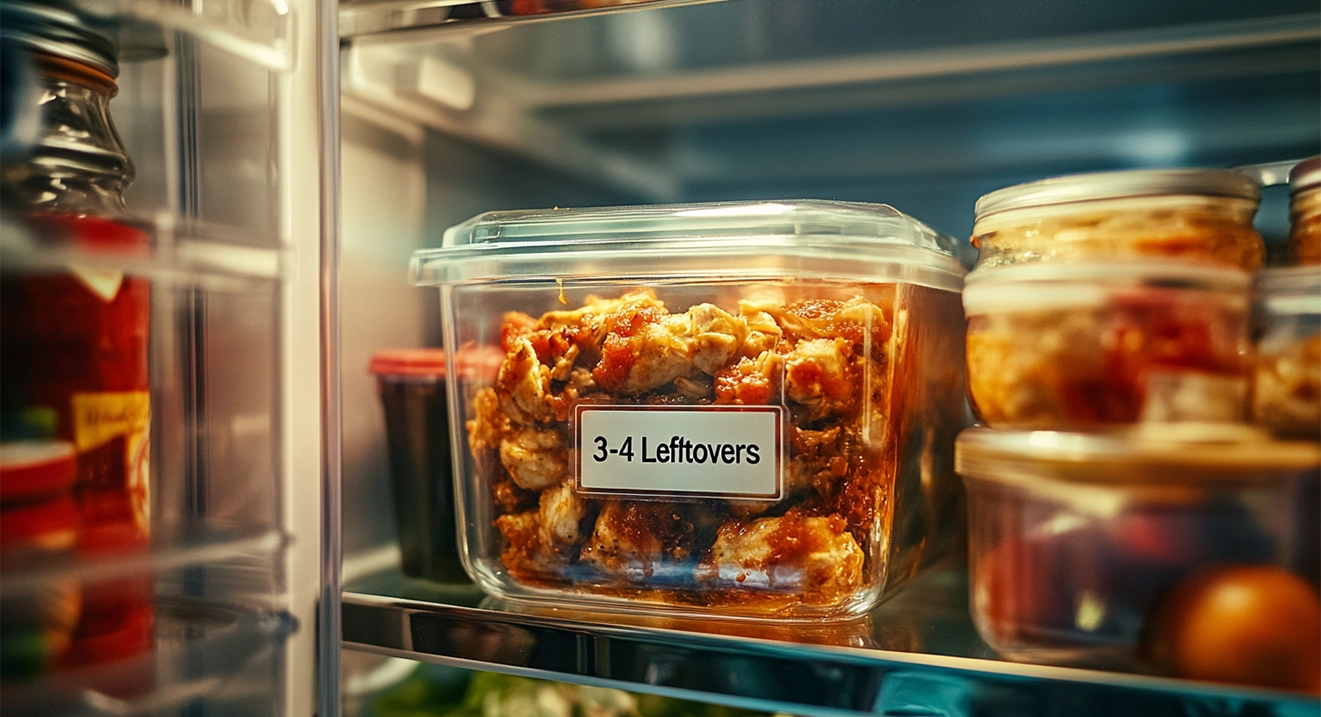
Introduction to Chicken Casserole Storage
Proper storage of chicken casserole is essential to maintaining its flavor, texture, and safety for consumption. Following the correct techniques can reduce the risk of foodborne illnesses, minimize waste, and ensure your meal remains as delicious as when it was first prepared.
Importance of Proper Storage Techniques
Like many other cooked dishes, chicken casserole is prone to spoilage if not handled correctly. Proper storage involves controlling factors like temperature, moisture, and exposure to air. When stored correctly, the chicken casserole can retain its quality and be safely reheated for later enjoyment.
Understanding Food Safety and Spoilage
Food safety is a critical consideration when storing chicken casserole. Bacteria such as Salmonella and E. coli can multiply rapidly in improperly stored food. These bacteria thrive in the “danger zone” temperatures between 40°F (4°C) and 140°F (60°C). To prevent spoilage:
- Cool Down Quickly: Transfer the casserole to shallow containers for rapid cooling before refrigeration.
- Refrigeration: Store in the fridge at 40°F (4°C) or below within two hours of cooking.
- Freezing: For extended storage, freeze the casserole at 0°F (-18°C) or below.
- Label and Date: Mark storage containers with dates to track freshness and prioritize older items.
Best Practices for Storing Chicken Casserole
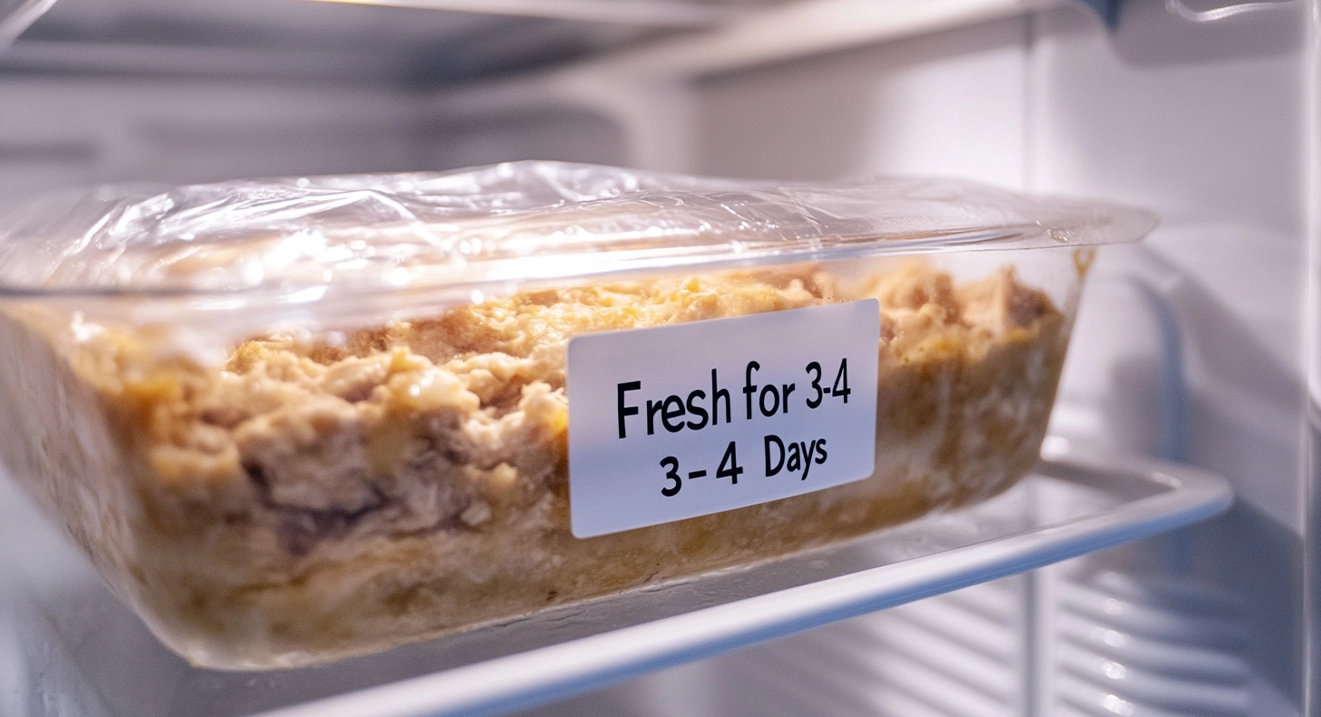
Properly storing chicken casserole ensures it remains fresh, flavorful, and safe. Here are some of the best practices to follow for optimal storage:
Refrigeration: Maintaining Ideal Temperatures
Refrigeration is key to preserving your chicken casserole. To maintain freshness and prevent bacterial growth:
- Cool It Quickly: Allow the casserole to cool to room temperature, but do not leave it out for more than two hours after cooking.
- Ideal Temperature: Store the casserole in the refrigerator at 40°F (4°C) or lower. Use a refrigerator thermometer to monitor temperature accuracy.
Covering and Sealing the chicken Casserole for Freshness
Proper covering and sealing are crucial to prevent contamination and moisture loss:
- Airtight Covers: To minimize air exposure, use airtight lids or tightly wrap the dish in plastic wrap or aluminum foil.
- Vacuum-Sealing Option: For longer-lasting freshness, consider vacuum-sealing casserole portions before storing.
Using Appropriate Storage Containers
The type of storage container can significantly affect the casserole’s shelf life:
- Shallow Containers: Opt for shallow, flat containers to allow even cooling and reheating.
- Glass or BPA-Free Plastic: Use food-safe materials such as glass or BPA-free plastic to avoid unwanted chemicals leaching into your food.
- Portioning: Divide the casserole into smaller portions to reduce reheating time and prevent repeatedly exposing the entire dish to air.
How Long Can a Chicken Casserole Stay Fresh in the Refrigerator?
Storing chicken casserole properly extends its shelf life while ensuring it remains healthy. Understanding general guidelines and signs of spoilage can help you make the most of your leftovers.
The General Rule for Cooked Chicken Casserole
Like most cooked chicken dishes, chicken casserole can stay fresh in the refrigerator for 3 to 4 days if stored correctly. Here are key points to remember:
- Refrigeration Timing: Place the casserole in the fridge within 2 hours of cooking to prevent bacterial growth.
- Temperature: Store at 40°F (4°C) or below to inhibit spoilage.
- Freezing Option: If you don’t plan to eat it within 4 days, freeze the casserole for more extended storage (up to 3 months for best quality).
Signs That a Casserole Has Gone Bad
Even when stored correctly, it’s essential to check for signs of spoilage before eating leftover chicken casserole:
- Unpleasant Odor: A sour, rotten, or off smell indicates spoilage.
- Discoloration: If the casserole has developed unusual colors, such as gray or green patches, discard it immediately.
- Texture Changes: A slimy or sticky texture on the surface is a sign of bacterial growth.
- Mold Growth: Any visible mold means the casserole is no longer safe to eat.
When in doubt, always err on the side of caution. Eating spoiled chicken casserole can lead to foodborne illnesses, so it’s better to discard it if you need clarification on its freshness.
Extending Shelf Life: Can You Freeze Chicken Casserole?
Freezing is an excellent way to extend the shelf life of chicken casserole, preserving its flavor, texture, and nutritional value. Using the proper techniques ensures that your casserole remains delicious and ready to enjoy for months.
Benefits of Freezing Casseroles
Freezing offers several advantages for storing chicken casseroles:
- Extended Shelf Life: While refrigerated casseroles last 3–4 days, freezing extends their usability for up to 3 months.
- Convenience: Pre-freezing casseroles in portion sizes makes reheating only what you need easy.
- Minimizes Waste: Freezing allows you to enjoy your meal later instead of discarding leftovers.
Proper Freezing Techniques to Prevent Freezer Burn
To maintain the quality of your chicken casserole and prevent freezer burn, follow these steps:
- Cool Before Freezing: Allow the casserole to cool completely before freezing to avoid condensation, which can lead to ice crystals.
- Use Airtight Containers: Store the casserole in freezer-safe, airtight containers or heavy-duty freezer bags. Press out as much air as possible to avoid freezer burn.
- Wrap for Extra Protection: If using a casserole dish, wrap it tightly with plastic wrap and aluminum foil for an additional barrier against air and moisture.
- Label and Date: Clearly label the container with the dish’s name and the date it was frozen.
How Long a Chicken Casserole Stays Safe in the Freezer
When stored properly, chicken casserole remains safe in the freezer for up to 3 months. After this period, it may still be safe to eat but might lose some of its flavor and texture.
- Reheating Tip: Thaw frozen casseroles overnight in the refrigerator before reheating for even cooking.
- Reheat Safely: Heat the casserole to an internal temperature of 165°F (74°C) to ensure it is safe to consume.
Reheating Chicken Casserole Safely
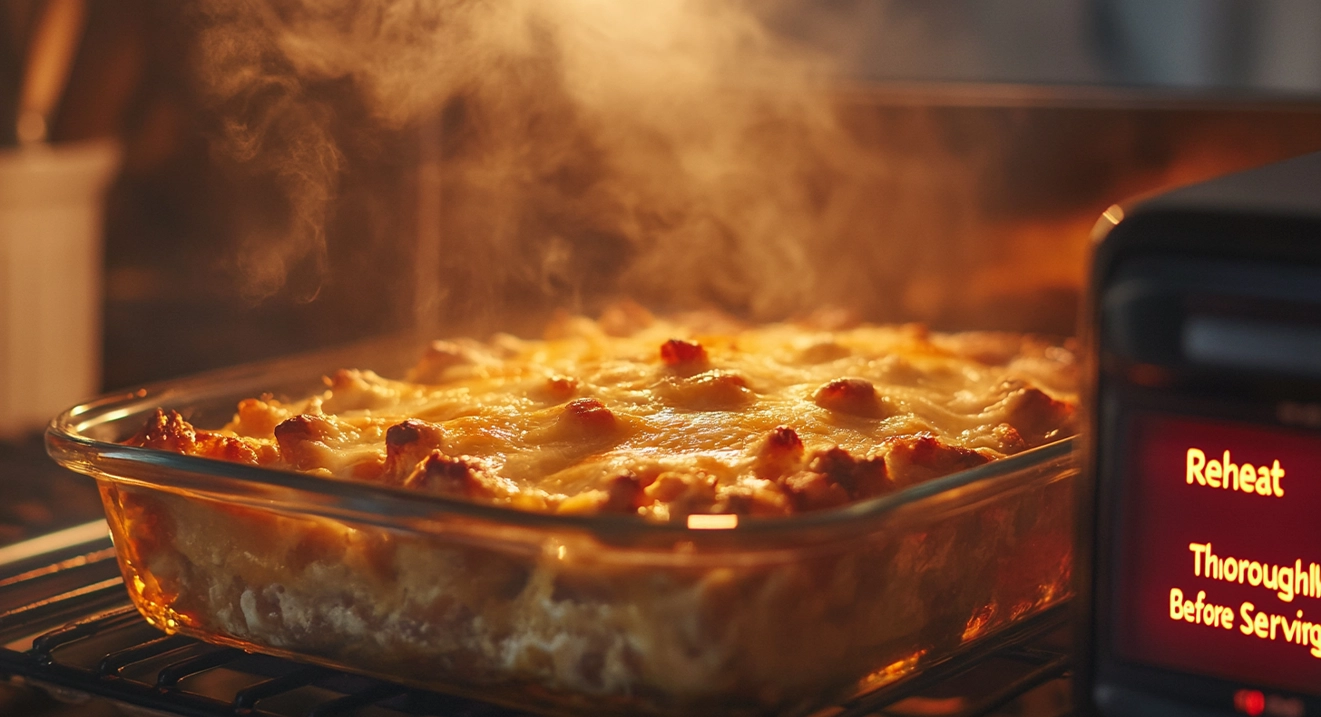
Reheating chicken casserole requires attention to ensure it is heated thoroughly and safely. Following the correct methods, you can enjoy your leftovers with the same deliciousness as the first serving.
The Right Methods for Reheating Casseroles
Depending on your equipment and time, choose one of these methods to reheat your chicken casserole:
- Oven:
- Preheat your oven to 350°F (175°C).
- If the casserole isn’t in an oven-safe dish, transfer it to one and cover it with aluminum foil to retain moisture.
- Heat 20–30 minutes, depending on the portion size, until the casserole is thoroughly warmed.
- Microwave:
- Use a microwave-safe container. Cover with a lid or microwave-safe wrap with a small vent if reheating from the fridge.
- Heat on medium power for intervals, stirring or rotating the dish to ensure even heating.
- Stovetop:
- For small portions, transfer the casserole to a skillet or saucepan.
- Heat over low to medium heat, stirring occasionally to prevent sticking, until warmed.
Ensuring Even Heating to Avoid Cold Spots
Cold spots in reheated food can harbor bacteria. To ensure even heating:
- Stir or rotate the casserole periodically, especially when using a microwave.
- Use a food thermometer to check the internal temperature. The casserole should reach a safe temperature of 165°F (74°C).
- Avoid reheating large portions all at once. Instead, divide into smaller sections for quicker and more uniform heating.
How to Tell if the Chicken Casserole Is Safe to Eat After Reheating
To ensure your reheated casserole is safe to eat, look for these signs:
- Temperature: Verify that all parts of the dish, especially the center, have reached 165°F (74°C).
- Texture and Moisture: If the casserole appears dried out or overly complicated, it may not be safe or enjoyable to consume.
- Smell: After reheating, an off or sour smell indicates spoilage, even if the casserole appears fine.
Food Safety Guidelines for Cooked Chicken Casserole
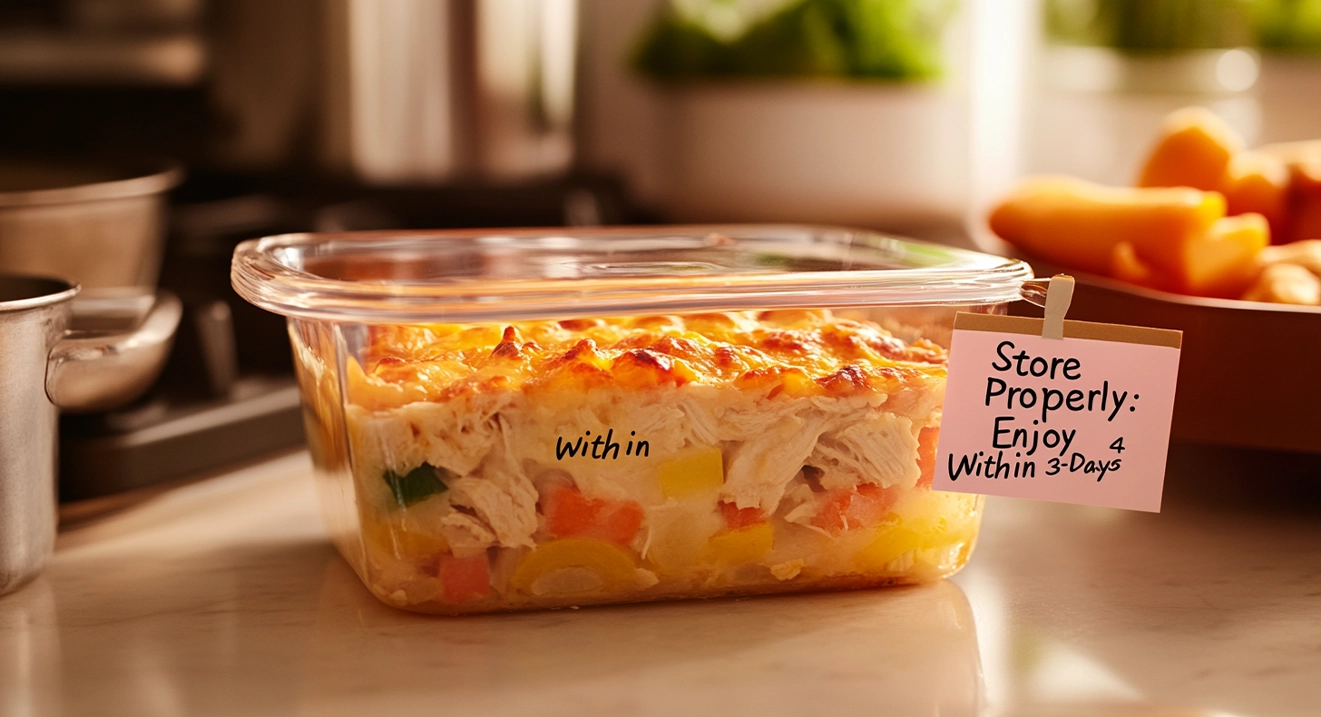
Proper handling, storage, and reheating of cooked chicken dishes are essential to prevent foodborne illnesses. By following the USDA guidelines and other food safety practices, you can ensure that your meals remain safe and enjoyable.
Guidelines from the USDA
The USDA provides clear recommendations to minimize the risk of bacterial contamination in cooked chicken dishes:
- Temperature Control:
- Cook chicken to a safe internal temperature of 165°F (74°C) to kill harmful bacteria.
- To prevent bacterial growth, keep cooked chicken out of the “danger zone” (between 40°F and 140°F, or four °C and 60°C).
- Time Limits:
- Do not leave cooked chicken at room temperature for more than 2 hours (or 1 hour if the room temperature exceeds 90°F/32°C).
- Store leftovers in the refrigerator within this time frame.
- Refrigeration and Freezing:
- Refrigerate chicken dishes at 40°F (4°C) or below.
- Freeze at 0°F (-18°C) or below if not consumed within 3–4 days.
How to Safely Handle and Store Leftovers
Proper handling and storage of leftovers ensure their safety and quality:
Handling Leftovers:
- Cool Quickly: Transfer hot chicken dishes to shallow containers for rapid cooling before refrigeration.
- Avoid Cross-Contamination: Use clean utensils and storage containers to handle and store leftovers.
Storing Leftovers:
- Refrigeration:
- Store in airtight containers or tightly wrapped with plastic or aluminum foil to prevent contamination and moisture loss.
- Label containers with the storage date to track freshness.
- Freezing:
- Portion leftovers into smaller servings for convenience and quicker freezing.
- Use freezer-safe containers or heavy-duty freezer bags to prevent freezer burn.
- Reheating:
- Always reheat chicken dishes to an internal temperature of 165°F (74°C) before consumption. Use a food thermometer for accuracy.
Common Myths About Leftover Casseroles
Misconceptions about storing and consuming leftovers can lead to unsafe practices. Let’s debunk two common myths about leftover casseroles to ensure you handle them correctly.
Myth: Leftovers Can Last a Week Without an Issue
While some believe leftovers are safe for a week, this is not recommended. According to food safety guidelines:
- Truth: Leftover casseroles are safe to consume within 3–4 days when stored in the refrigerator at 40°F (4°C) or below. Beyond this timeframe, bacteria can multiply even in chilled conditions, increasing the risk of foodborne illness.
- Why It Matters: Harmful bacteria like Listeria and Salmonella may not change the smell, taste, or appearance of food, making spoiled leftovers appear safe to eat.
What You Should Do: Always label leftovers with the storage date and discard them after 4 days if refrigerated. For more extended storage, freeze them instead.
Myth: Freezing Preserves Casseroles Indefinitely
Freezing is a great way to extend the shelf life of casseroles, but it doesn’t make them last forever.
- Truth: Freezing slows bacterial growth and preserves food quality, but casseroles are best consumed within 3 months for optimal taste and texture. Over time, freezer burn and changes in texture can occur, even in well-packaged casseroles.
- Why It Matters: While the food may remain technically safe to eat beyond 3 months, the quality will degrade, leading to a less enjoyable meal.
What You Should Do: For the best experience, use freezer-safe containers, label casseroles with the freezing date, and plan to consume them within 3 months.
Final Note
Understanding and following proper food safety practices debunks these myths and helps you enjoy your leftover casseroles safely and with confidence.
FAQs About Chicken Casserole Storage
Here are answers to some of the most commonly asked questions about storing chicken casseroles to ensure they remain safe and enjoyable.
How long can I keep a chicken casserole in the fridge?
Chicken casserole can be stored in the refrigerator for up to 3–4 days if kept at 40°F (4°C) or below. Store it in an airtight container or tightly wrap it to prevent contamination and retain moisture.
Can I eat cooked chicken after 5 days?
Eating cooked chicken, including chicken casserole, is not recommended after 5 days. The USDA advises consuming cooked chicken within 3–4 days to avoid the risk of foodborne illness, even if the chicken looks and smells fine.
How long do casseroles stay good with chicken?
Casseroles made with chicken follow the same storage guidelines as other cooked chicken dishes:
- Refrigerator: 3–4 days at 40°F (4°C) or below.
- Freezer: Up to 3 months at 0°F (-18°C) for the best quality.
Proper storage in airtight containers or freezer-safe packaging ensures they stay fresh and safe during these timeframes.
How long will a casserole last in the fridge?
Most casseroles, especially those containing perishable ingredients like chicken, are best consumed within 3–4 days when refrigerated. Always store casseroles promptly after cooking and label them with the storage date to track freshness.
Final Tip
When in doubt, use a food thermometer to ensure the casserole is reheated to an internal temperature of 165°F (74°C) before consuming. If you’re unsure about the safety of leftovers, it’s better to discard them than risk illness.
Conclusion
Proper storage and handling of chicken casseroles are essential for maintaining their safety, freshness, and flavor. By following the guidelines and best practices discussed, you can enjoy your leftovers without compromising on quality or health.
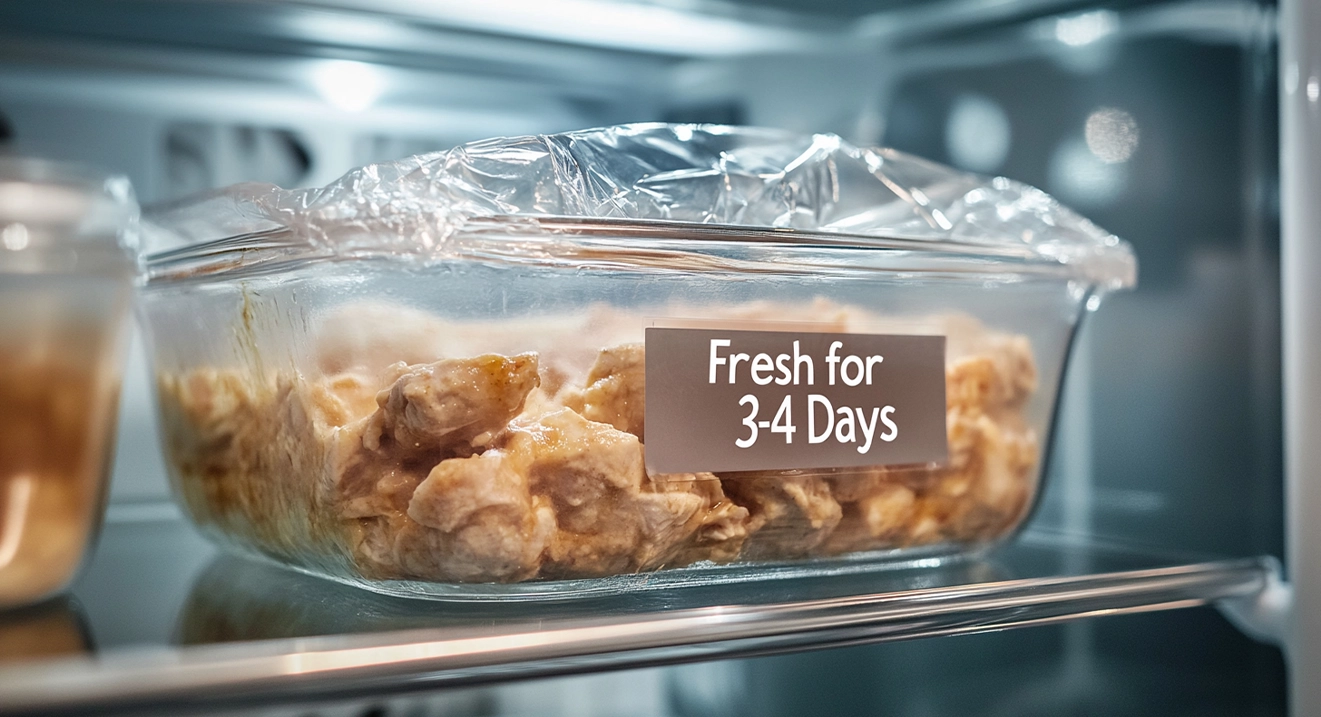
Key Takeaways for Safe Storage and Extended Shelf Life
- Refrigeration: Store chicken casseroles in the fridge within 2 hours of cooking, and consume them within 3–4 days to prevent spoilage.
- Freezing: For longer storage, freeze casseroles in airtight, freezer-safe containers, and consume them within 3 months for the best taste and texture.
- Reheating: Always reheat casseroles to an internal temperature of 165°F (74°C) to ensure food safety. Stir or rotate the dish during reheating to avoid cold spots.
- Food Safety Practices: Label leftovers with storage dates, handle them with clean utensils, and avoid keeping food in the “danger zone” temperatures.
